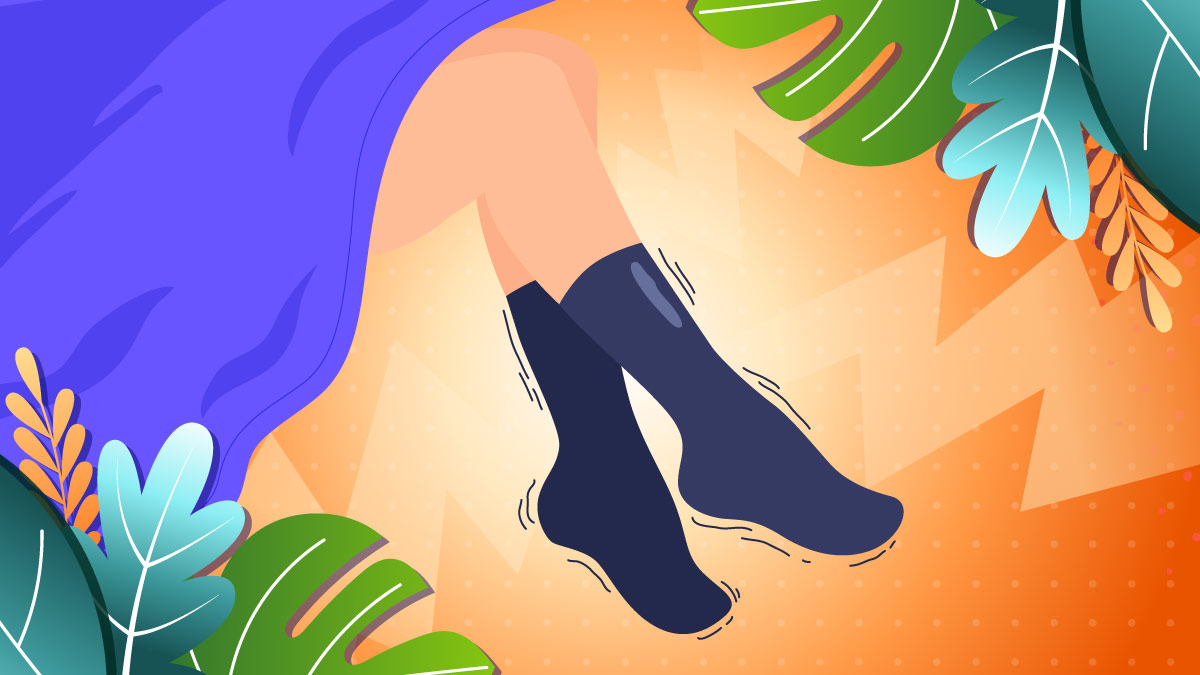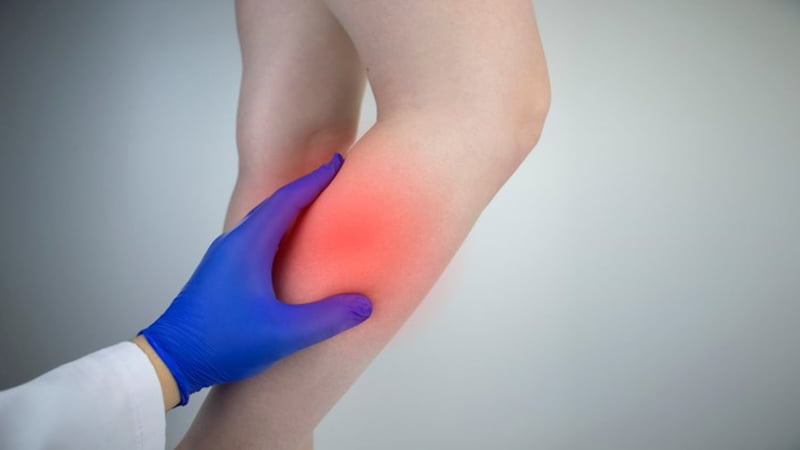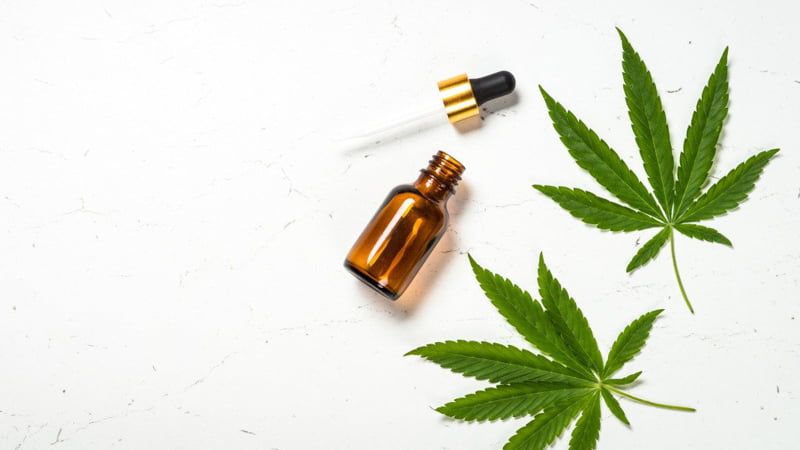CBD for Restless Legs Syndrome: Effects & Dosage

Untreated restless legs syndrome (RLS) has consequences that affect your overall quality of life. It prevents you from getting restful sleep, which impacts your physical health. It also puts you at risk of developing mental health issues such as depression and anxiety.
Medications help control RLS symptoms, but prolonged use of these drugs sometimes has ugly side effects.
CBD, as research studies suggest, has properties that may help control your RLS symptoms and improve your quality of life. It’s also non-psychoactive, non-toxic, and safe.
Read more to know what RLS is, how CBD helps with this neurological disorder, and how to use CBD for restless legs syndrome.
What is Restless Legs Syndrome?
Restless legs syndrome is a type of neurological disorder that causes a painful throbbing, pulling, itching, or electric sensation in the legs. An uncontrollable need to move the legs also accompanies the sensation.
These unpleasant sensations typically occur late in the afternoon or the evening hours but progressively worsen at night when you’re resting or sleeping. The symptoms also often wake you up and prevent you from going back to sleep. Inactivity, prolonged sitting, and stress typically make the symptoms worse, and moving the legs or walking relieves them.
RLS has no known cause, but a 2020 study published in the International Journal of Environmental Research and Public Health suggests that genetics, kidney disease, and an imbalance in the neurotransmitter levels in the brain may be the causative factors.
Health problems like peripheral nerve damage, kidney failure, iron deficiency, and spinal cord problems also increase RLS risks.
How is Restless Legs Syndrome Treated?

If left untreated, RLS will start affecting the quality of your life.
Because you’re not getting enough sleep, you’ll feel exhausted all the time, with your daytime fatigue affecting your activities of daily living. Mood swings, easy irritability, inability to concentrate, poor memory, short attention span, and sleep deprivation may also occur. Sleep deprivation and RLS symptoms will also impact your mental health and may cause anxiety and depression.
The treatment for RLS consists of finding the underlying cause and treating the problem. Once the root cause is treated, there’s usually an improvement in the RLS symptoms.
If no underlying cause was found, then lifestyle modification may be suggested. These include:
- Diet change
- Regular exercise program
- Healthier sleep habits
- Warm baths
- Avoidance of caffeinated beverages
- Smoking or alcohol cessation
Prescription medications may also be given such as:
- Muscle relaxants for muscle cramps and spasms
- Sleep aids for sleep problems
- Painkillers like opioids for severe pain
- Anticonvulsant drugs like gabapentin
- Dopamine agonists like rotigotine and ropinirole
Short-term effects of these drugs may cause nausea, dizziness, and fatigue. However, prolonged use may also result in drug tolerance, in which case you’ll need a higher dose of the same medication or a different medication altogether. Long-term use may also cause worsening of your RLS symptoms.
CBD, on the other hand, is a safe, non-toxic, and non-psychoactive cannabinoid that may be used for RLS. Before we discuss CBD for restless legs syndrome, let’s first go over the role of the endocannabinoid system.
The Endocannabinoid System and Restless Legs Syndrome
The endocannabinoid system (ECS) is involved in many physiological functions — from regulating appetite and stress to controlling an abnormal inflammatory response. It consists of three components: the endocannabinoids, the cannabinoid receptors (CB1R and CB2R), and the enzymes that degrade the endocannabinoids.
You’ll find cannabinoid receptors all over the body, including the peripheral tissues. However, the brain and the spinal cord have the most abundant numbers of CB1R. This is why its activation results in the modulation of many physiological functions such as appetite, hunger, fear, memory, stress, anxiety, pain, pleasure, sleep, as well as sensory and motor responses, etc.
The CB2R, on the other hand, is mostly found in the immune system, and its activation results in decreased inflammation.
The main role of the ECS is to make sure there’s a balance among the different chemicals inside the body. Unfortunately, noxious stimuli like pain, infection, or diseases easily disrupt this balance and cause symptoms. If left untreated, this imbalance can contribute to ECS dysfunction.
In RLS, for example, low levels of dopamine in the region of the brain controlling motor movements cause painful muscle spasms and cramps. Iron deficiency also contributes to fatigue, dizziness, and joint pains, which worsen RLS symptoms.
Studies suggest that inflammation caused by chronic health problems also plays a role in the worsening of RLS symptoms. It contributes to abnormal dopamine and iron levels in the brain.
We lack studies that focus on the ECS and RLS, but ECS dysregulation has been implicated in diseases like multiple sclerosis, Huntington’s disease, and Parkinson’s disease. Similar to RLS, these neurological diseases also cause motor problems. Parkinson’s disease, in particular, shares similar features with RLS since they both have abnormal dopamine levels.
According to an issue published in the Brazilian Journal of Psychiatry, patients with Parkinson’s disease respond well to CBD. This effect may be one of the reasons why CBD for restless legs helps.
What are the Effects of CBD for Restless Legs Syndrome?

CBD is a non-psychoactive cannabinoid that doesn’t dock very well on the CB1R. However, it binds to several receptors like the serotonin, vanilloid, adenosine, and PPARy receptors to produce its therapeutic effects.
CBD directly stimulates the CB2R though, producing a strong anti-inflammatory response.
Below are the effects CBD may have on RLS symptoms.
CBD for Pain
The classic symptom of RLS is a pain in the legs that get worse at night. It’s often described as throbbing, pulling, crawling pain inside the legs, and some also describe it as an itching and electric pain. The pain becomes severe when resting or sleeping, and an uncontrollable urge to move the legs often temporarily relieves the unpleasant sensation.
CBD produces strong analgesic effects when it binds to the vanilloid, adenosine, and PPARy receptors. These receptors play active roles in controlling pain sensation.
When CBD binds to these receptors, the cells stop secreting pain-generating compounds. They start releasing compounds that counteract the effects of the pain-generating ones. This CBD effect also stimulates the cells to reabsorb the pain-generating chemicals, reducing their levels in the system.
CBD for Inflammation
Low-grade inflammation caused by chronic health problems plays a role in RLS and may contribute to decreased dopamine and iron levels in the brain, fatigue, and chronic widespread pain.
CBD exerts its anti-inflammatory effects through the CB2R, serotonin, vanilloid, PPARy, adenosine, and GPR55 receptors. Activation of these receptors results in apoptosis or cell death of the immune cells. This effectively stops the immune cells from sending signals for more immune cells to the site.
This CBD effect only affects the abnormal immune cells while protecting the healthy cells.
CBD for Muscle Spasms and Cramps
The National Institute of Neurological Disorders and Stroke notes that more than 80% of individuals suffering from RLS also complain of periodic limb movement of sleep (PLMS). These muscle jerks and spasms typically occur during sleep, with an interval of about 15 to 40 seconds between each involuntary movement.
CBD produces muscle relaxant effects and anticonvulsants through the non-cannabinoid receptors. Their activation prompts the brain cells to slow down their release of excitatory neurotransmitters while increasing their release of inhibitory ones. CBD also allows the endocannabinoids to stay longer in the system by attaching to the enzymes that break them down.
CBD for Stress, Anxiety, and Depression
If you’re suffering from RLS, you’re at a higher risk of developing chronic stress as well as depression and anxiety. RLS also makes you more vulnerable to panic disorders.
CBD reduces stress and anxiety, and it also improves symptoms of depression by stabilizing the abnormal neurotransmitter levels in the brain. Again, these CBD effects are through its activation of non-cannabinoid receptors such as the vanilloid and serotonin receptors.
CBD for Sleep
You never get a full, restful sleep when your RLS attacks. The painful sensation keeps you up at night, and the muscle twitches sometimes pull you out of sleep. If left untreated, RLS results in sleep deprivation, which impacts your overall mental and physical well-being.
CBD not only relieves several symptoms associated with RLS but also improves sleep. A study published in The Permanente Journal revealed that CBD improved the duration and quality of sleep in patients with anxiety problems.
CBD for Restless Legs Syndrome
We lack specific studies that focus on CBD for RLS, but one notable study published in Sleep Medicine showed that smoking marijuana and sublingual CBD improved the sleep quality of six patients with RLS.
The study also noted that cannabis use was effective in controlling RLS symptoms. It’s also well-tolerated by the patients.
How to Find the Best CBD Dose for Restless Legs Syndrome?
Unlike other popular supplements in the market, CBD doesn’t have a recommended daily intake. Yes, you’ll see label instructions telling you to take one dropper daily, but the CBD dose it contains may not be the best dose for you. Depending on the total milligrams of CBD in the bottle, one dropper can either be too low or too high.
The best way to find your CBD dose is to follow this simple rule:
- For mild symptoms or low-strength CBD, take 1 mg of CBD per 10 pounds of body weight
- For moderate symptoms or medium-strength CBD, take 3 mg of CBD per 10 pounds of body weight
- For severe symptoms or high-strength CBD, take 6 mg of CBD per 10 pounds of body weight
For example, if you weigh 120 pounds and have mild RLS symptoms, then you need at least 12 mg of CBD (36 mg of CBD for moderate symptoms and 72 mg of CBD for severe symptoms).
Let’s say you bought a 30 mL bottle containing a total of 750 mg of CBD, then divide 750 by 30, and you get 25 mg of CBD per one full dropper. Each dropper contains at least 20 drops, so divide 25 by 20, and you get 1.25 mg of CBD per drop.
Since you need 12 mg of CBD for your mild RLS symptoms, divide 12 by 1.25 and you get 9.6. This means that you need at least 10 drops for symptom control.
You can also buy extra-strength CBD oil for moderate to severe symptoms. It may be a bit pricier, but it will last you a long time.
How to Choose the CBD Product?

Looking for CBD products shouldn’t be difficult. CBD’s popularity has made it readily available in the market. However, this doesn’t mean though that you have to buy the first product you see.
Instead, you should be extra careful when buying CBD to avoid mistakes, especially since there’s the risk of buying illegal and/or substandard CBD products.
When buying CBD, always consider these factors.
CBD Source and Extraction Process
Make sure it’s an organic CBD that is sourced from organically grown plants. This reduces your risk of buying contaminated CBD products since no artificial fertilizers and pesticides were used in growing the plants.
There are many ways to extract CBD, including the use of solvents like ethanol, alcohol, butane, oil, and carbon dioxide. Of these methods, the supercritical CO2 extraction process is, by far, the safest and cleanest method that produces pure, residue-free CBD.
CBD Legal Status
The 2018 Farm Bill legalized industrial hemp. This means that we can now use all the parts of the plant legally, including its leaves, stems, flowers, cannabinoids, extracts, derivatives, isomers, acids, etc., as long as its THC level doesn’t go over 0.3%. Cannabis plants containing more than 0.3% THC are considered marijuana and are illegal under federal laws.
People, regardless of age, have access to hemp-derived CBD products. You don’t need to get a letter of recommendation or a prescription from your doctor. You can simply buy CBD from dispensaries, health stores, and online CBD shops. There’s also no restriction on the amount of hemp-derived CBD products you can possess.
Marijuana-derived CBD products, on the other hand, are only available to people residing in states that legalized marijuana. Some states require patients to register into their medical marijuana program to get a card, while other states don’t. You only have to present a valid ID as proof that you’re of legal age to buy marijuana-derived CBD with higher THC content.
Before buying CBD products, we recommend checking your state’s cannabis laws.
Certificate of Analysis
One of the differentiating factors between a good CBD and a bad CBD product is its COA.
Legitimate CBD producers send samples of their products to certified facilities for laboratory testing. The tests look for contaminants such as heavy metals, toxic residues, residual solvents, harmful microbes, etc. They also check the potency of the products by getting the cannabinoid profile and their concentration.
The COA is proof that the product underwent third-party testing. You’ll see this on the product label and the producer’s website.
Don’t buy CBD products that don’t have COAs. You’re not guaranteed their safety, quality, and potency.
Types of CBD
When choosing CBD products, you’ll encounter the different types of CBD products:
- Pure CBD which has only CBD and no other extra ingredients
- Broad-spectrum CBD which also has other cannabinoids and terpenes
- Full-spectrum CBD which also has THC, in addition to the extra cannabinoids and terpenes
They all help, but with full-spectrum CBD oil, you also benefit from the entourage effect. This is a cannabis phenomenon that states that all the compounds found in the plant (including THC) work together and boost each other’s therapeutic effects.
Forms of CBD
You’ll also encounter different forms of CBD such as sublingual, edible, inhalable, and topical CBD products.
Sublingual and inhalable CBD products give you fast relief since the cannabinoid bypasses the digestive organs and the liver. You’ll feel the effects in under 30mins. However, the effects don’t last as long as edibles.
Edible CBD takes some time before you feel the effects (about 30 minutes to 1.5 hours) since it goes through the digestive system and liver first before joining the blood circulation. However, the effects last longer since the cannabinoid circulates in the body for a longer period.
Topical CBD creams stimulate the cannabinoid receptors found on the skin and help provide immediate relief to muscles and joints.
Product Reviews
Once you’ve chosen a CBD product (with consideration of the factors above), the last step is to read reviews. Customer feedback and their experience already tell a lot about the CBD product.
Of course, stay away from CBD products that received more negative than positive reviews.
Is CBD Safe?
CBD is safe and non-toxic. There may be some side effects like eye and mouth dryness or lightheadedness, but these are usually well-tolerated and typically go away in time.
Final Thoughts — Can CBD for Restless Legs Syndrome Help?
Can CBD for restless legs syndrome help control symptoms?
There’s no study yet that purely focuses on CBD for RLS, but other CBD studies show that this non-psychoactive cannabinoid has many properties that relieve RLS symptoms. It helps with unpleasant sensations in the legs, and it also relaxes the muscles. CBD may also help with associated RLS symptoms like sleep loss, increased anxiety, and depression. Moreover, CBD helps control low-grade inflammation, which contributes to the worsening of RLS symptoms.
Are you using CBD for restless legs syndrome? Has it helped with your symptoms? Comment your story below!
References Used in This Article:
- Seeman M. V. (2020). Why Are Women Prone to Restless Legs Syndrome?. International journal of environmental research and public health, 17(1), 368. https://doi.org/10.3390/ijerph17010368
- Memon, M. D., Faiz, S., Zaveri, M. P., Perry, J. C., Schuetz, T. M., & Cancarevic, I. (2020). Unraveling the Mysteries of Restless Leg Syndrome. Cureus, 12(10), e10951. https://doi.org/10.7759/cureus.10951 [1]
- Weinstock, L. B., Walters, A. S., & Paueksakon, P. (2012). Restless legs syndrome–theoretical roles of inflammatory and immune mechanisms. Sleep medicine reviews, 16(4), 341–354. https://doi.org/10.1016/j.smrv.2011.09.003 [2]
- Centonze, D., Battistini, L., & Maccarrone, M. (2008). The endocannabinoid system in peripheral lymphocytes as a mirror of neuroinflammatory diseases. Current pharmaceutical design, 14(23), . https://doi.org/10.2174/138161208785740018
- Tan E. K. (2006). Restless legs syndrome and Parkinson’s disease: is there an etiologic link?. Journal of neurology, 253 Suppl 7, VII33–VII37. https://doi.org/10.1007/s00415-006-7008-1
- Rieder C. R. (2020). Cannabidiol in Parkinson’s disease. Revista brasileira de psiquiatria (Sao Paulo, Brazil : 1999), 42(2), 126–127. https://doi.org/10.1590/1516-4446-2019-0810
- Russo E. B. (2008). Cannabinoids in the management of difficult to treat pain. Therapeutics and clinical risk management, 4(1), 245–259. https://doi.org/10.2147/tcrm.s1928
- Stehlik, R., Ulfberg, J. (Neuro)Inflammatory Component May Be a Common Factor in Chronic Widespread Pain and Restless Legs Syndrome. Curr Sleep Medicine Rep 6, 121–128 (2020). https://doi.org/10.1007/s40675-020-00180-0 [3]
- Atalay, S., Jarocka-Karpowicz, I., & Skrzydlewska, E. (2019). Antioxidative and Anti-Inflammatory Properties of Cannabidiol. Antioxidants (Basel, Switzerland), 9(1), 21. https://doi.org/10.3390/antiox9010021 [4]
- National Institute of Neurological Disorders and Stroke. (2020, March 17). Restless Legs Syndrome Fact Sheet. Retrieved September 3. 2021, from https://www.ninds.nih.gov/Disorders/Patient-Caregiver-Education/Fact-Sheets/Restless-Legs-Syndrome-Fact-Sheet
- Peres, F. F., Lima, A. C., Hallak, J., Crippa, J. A., Silva, R. H., & Abílio, V. C. (2018). Cannabidiol as a Promising Strategy to Treat and Prevent Movement Disorders?. Frontiers in pharmacology, 9, 482. https://doi.org/10.3389/fphar.2018.00482 [5]
- Winkelmann, J., Prager, M., Lieb, R., Pfister, H., Spiegel, B., Wittchen, H. U., Holsboer, F., Trenkwalder, C., & Ströhle, A. (2005). “Anxietas tibiarum”. Depression and anxiety disorders in patients with restless legs syndrome. Journal of neurology, 252(1), 67–71. https://doi.org/10.1007/s00415-005-0604-7
- de Mello Schier, A. R., de Oliveira Ribeiro, N. P., Coutinho, D. S., Machado, S., Arias-Carrión, O., Crippa, J. A., Zuardi, A. W., Nardi, A. E., & Silva, A. C. (2014). Antidepressant-like and anxiolytic-like effects of cannabidiol: a chemical compound of Cannabis sativa. CNS & neurological disorders drug targets, 13(6), 953–960. https://doi.org/10.2174/1871527313666140612114838
- Shannon, S., Lewis, N., Lee, H., & Hughes, S. (2019). Cannabidiol in Anxiety and Sleep: A Large Case Series. The Permanente journal, 23, 18–041. https://doi.org/10.7812/TPP/18-041